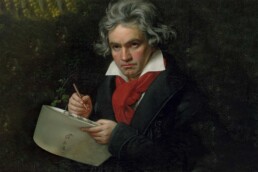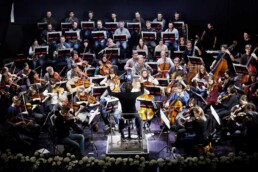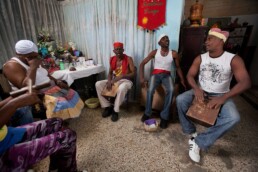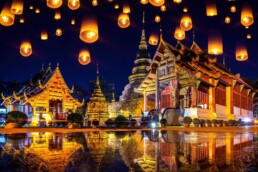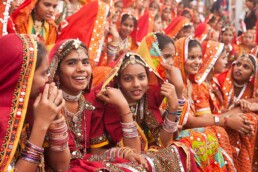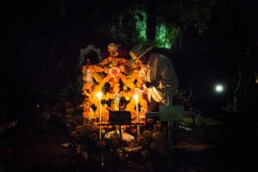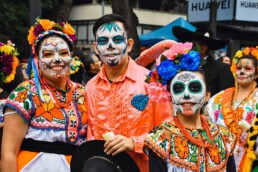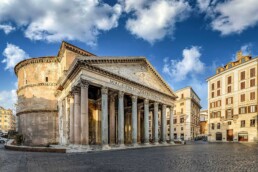Beethoven's Symphony of Joy
The beautiful hills of Bonn, Germany, witnessed the development of one of history’s most transformative composers in 1770. A child prodigy, born to a court musician father, began his path in a chaotic environment, rather than with privilege. From a young age, this youngster was motivated by music, sculpted by hard discipline and a desire to transcend the ordinary.
The latter half of the eighteenth century was a period of colossal upheaval. Enlightenment ideals collided with existing regimes, resulting in uprisings across Europe. Against this setting, a young composer immersed himself in the Classical traditions established by Haydn and Mozart. Nonetheless, even in his early years, whispers of an unbreakable spirit and revolutionary flair distinguished him. This was no ordinary imitator; this was an artist destined to push the frontiers of music itself.
In an era ripe for revolution, grand symphonies, intimate sonatas, and ground-breaking concertos emerged. His Third Symphony, *Eroica*, originally dedicated to Napoleon Bonaparte, defied expectations with its audacious length and emotional depth. The Fifth Symphony, with its signature “fate knocking at the door” motif, is still one of the most recognised works in Western music. Piano sonatas such as the *Moonlight Sonata* and *Pathétique* demonstrate the depth of his contemplative brilliance.
Perhaps his best effort, the Ninth Symphony, concludes with the *Ode to Joy*, a choral climax that depicts global brotherhood—a feeling that continues to reverberate today. Such masterpieces were more than just compositions; they were expressions of human perseverance and transcendence.
Few incidents in the history of art are more heartbreaking and uplifting than the loss of a master composer’s hearing. Deafness began as a minor condition in his late twenties and gradually worsened, sinking him into despair. The renowned *Heiligenstadt Testament*, a letter he penned but never mailed, depicts his internal struggle: on the verge of death, he decided to live for his work. Against all odds, his disability fuelled his creativity rather than hindering it. During this period of intense quiet, Beethoven composed some of his most famous compositions, including the Ninth Symphony.
While widely honoured, his life was not without controversy. His volatile disposition, described by contemporaries as unpleasant and erratic, alienated many of those around him. Legal fights over custody of his nephew Karl revealed a very flawed but human side, characterised by possessiveness and domineering tendencies. Even romantic endeavours were plagued with heartbreak. The mystery of the “Immortal Beloved,” an unidentified character referenced in a passionate letter, continues to fascinate academics and fans.
Critics of his period were frequently divided, with some praising his creativity and others dismissing his drastic departures from norm. However, history has been clear in its assessment. His works provided the groundwork for the Romantic era, influencing figures such as Brahms, Wagner, and others.
The premiere of the Ninth Symphony in 1824 was one of the most melancholy occasions of his life. Unable to hear the thunderous clapping, he reportedly turned around to see the audience’s overwhelming adulation. This one event represents not just creative accomplishment, but also human tenacity in the face of enormous circumstances.Another defining event was his funeral in 1827. Over 20,000 people packed the streets of Vienna to say goodbye, demonstrating his great influence on his contemporaries and the musical world.
His works continue to have a profound impact across genres, civilisations, and centuries. His compositions have appeared in a variety of settings, including grand orchestral concerts, film scores, advertisements, and pop music. The *Ode to Joy* serves as the European Union’s anthem, representing ideals of unity and peace.
Modern interpretations of his life and work continue to flourish, ranging from biographies and films to academic research that reveals new insights into his creative processes. For many, his life story exemplifies the limitless potential of human ingenuity, especially in the face of tragedy.
The capacity to connect across time is what distinguishes a genius, and this composer’s music does just that. His compositions encourage listeners to go into the depths of emotion, the heights of human aspiration, and the beauty of artistic inventiveness. In an ever-changing world, his music serves as a constant, a bridge to the sublime that reminds us of our common humanity.
The Rhythms and Colours of Naga Legacy
Every December, a spectacular celebration takes place in the undulating hills of Nagaland, India, attracting visitors and culture aficionados from all over the world. The Hornbill Festival, named after the beloved bird fundamental to Naga culture, is more than just a demonstration of traditions; it is a celebration of legacy, tenacity, and unity.
Long before the celebration became an annual spectacle, Nagaland’s numerous tribes performed their customs and rituals independently. Each tribe, from the Ao to the Konyak, protected their distinct traditions, art forms, and dialects. Recognising the importance of preserving and sharing this cultural heritage, the Nagaland government established the Hornbill Festival in 2000. Conceived as a cultural fusion, the festival aims to unite the state’s 16 tribes while also promoting tourism and the region’s rich legacy.
The event is named after the hornbill, a mystical bird in Naga culture that represents prosperity and legend. It also represents the Naga tribes’ affinity to nature, since the hornbill is frequently depicted in traditional jewellery, dances, and storytelling.
A sensory feast awaits visitors to Kisama Heritage Village, the festival grounds, as soon as they enter. The air is filled with the rhythmic pounding of log drums, interspersed with the sounds of tribal music. Each tribe sets up its own morung—a traditional house that serves as a cultural pavilion—to give tourists a look into their way of life. These carefully built structures serve as centres for storytelling, music, and artisan demonstrations, bridging the gap between past and present.
Traditional dance performances are among the festival’s most engaging attractions. Dancers, dressed in intricate costumes made of feathers, beads, and vivid textiles, move in sync while recounting stories of valour, romance, and harvest. These performances are more than just creative manifestations; they are profoundly ingrained in the tribes’ spiritual beliefs and collective identity.
The aroma of traditional Naga cuisine permeates the festival grounds, enticing visitors to sample the region’s rich flavours. The delicacies, which range from smoky pork with bamboo shoots to spicy axone (fermented soybean) chutney, represent the Naga people’s inventiveness and strong attachment to their land. Adventuresome foodies frequently sample uncommon dishes such as silkworm larvae and snails, demonstrating Nagaland’s wide culinary heritage.
Local rice beer, produced in traditional earthen pots, flows freely and adds to the joyous atmosphere. Sharing a cup of this earthy drink is widely used as a bonding ritual between residents and guests, breaking down linguistic and cultural boundaries.
While the Hornbill Festival is a celebration of heritage, it also demonstrates Naga culture’s persistence in the face of modernity. The festival allows indigenous craftsmen to demonstrate their crafts, ranging from finely woven shawls to hand-carved wooden sculptures. These masterpieces not only conserve traditional traditions, but they also benefit the local economy by empowering craftspeople to maintain their history.
In addition to cultural performances, modern events like rock concerts, fashion exhibitions, and motor rallies illustrate Nagaland’s developing character. The blend of traditional and modern features demonstrates Naga society’s versatility, honouring both its origins and its future goals.
The Hornbill Festival has evolved into a symbol of solidarity not only for the people of Nagaland, but also for India’s northeast. It has drawn global attention to the state, boosting sustainable tourism and fostering a better appreciation of its distinct culture. However, the festival raises concerns about the commercialisation of traditions. The organisers continue to struggle with striking a balance between keeping authenticity and adjusting to current demands.
For Nagaland’s tribes, the festival is more than just a cultural display; it is a reaffirmation of identity in a rapidly changing world. The Hornbill Festival guarantees that the Naga people’s legacy lives on by passing down songs, stories, and traditions to future generations.
The Hornbill Festival is more than a tourist attraction; it also functions as a cultural bridge. It invites visitors to immerse themselves in Nagaland’s rhythms, colours, and flavours, establishing connections across geographical and cultural borders. Each December, Kisama Heritage Village transforms into a vivid tapestry of people, with customs embraced, memories shared, and a sense of community reigning.
The festival’s echoes reverberate long after it ends, leaving visitors with a deep understanding for the Naga culture. In the midst of the hills, the Hornbill Festival serves as a timeless reminder of the beauty of diversity and the enduring force of cultural history.
The Nostradamus Effect: Belief, Skepticism, and Mystery
Michel de Nostredame, a young apothecary’s son, was born in 1503 in Saint-Rémy-de-Provence, France, and went on to become one of history’s most mysterious individuals. The Renaissance-era physician, astrologer, and author wrote cryptic quatrains in his magnum opus, “Les Prophéties”, a work that continues to pique interest and provoke controversy centuries after its publication in 1555. Nostradamus’ origins were entrenched in a mixing pot of Jewish history, scientific inquiry, and mysticism, all of which created his distinctive worldview and fuelled his disputed predictions.
Following a period of plague and ecclesiastical strife, the seer studied medicine at the University of Avignon and later Montpellier. His work as a healer during the Black Death established him as a man of science, but his interests soon shifted to the celestial. By studying planetary alignments and interpreting ancient texts, Nostradamus developed a prophetic technique that combined astrology with a thorough understanding of historical cycles. This duality—scientist and mystic—became the defining feature of his life and career.
Some of the 942 quatrains in “Les Prophéties” have been regarded as predictions of key world events. One of the most often reported prophesies states:
“From the depths of the West of Europe, A young child will be born of poor people, He who by his tongue will seduce a great troop; His fame will increase towards the realm of the East.”
This quatrain is frequently attributed to Adolf Hitler, despite its ambiguous phrasing that allows for interpretation. Another intriguing case cites “two steel birds” dropping from the sky, which some have linked to the 9/11 attacks. While these interpretations pique the interest, others contend that the wording is so imprecise that it may be modified to fit almost any noteworthy event.
The attraction of his work stems from its obscure nature, yet detractors have long rejected Nostradamus’ forecasts as nothing more than lyrical riddles. Deciphering the scholar’s aim is difficult due to his use of metaphor, anagrams, and cryptic references, which frequently leads to drastically divergent interpretations. Sceptics further point out the post-hoc nature of his claimed accuracy, stating that many linkages to historical events were drawn after the events had transpired.
In the internet era, Nostradamus’ quatrains have gained a new audience. Social media platforms and online forums are full with allegations relating his work to current challenges ranging from climate change to artificial intelligence. Some admirers believe his forecasts foreshadow a worldwide battle or perhaps extraterrestrial contact. Conspiracy theories abound, with some claiming that his writings include a hidden code designed to lead humanity through turbulent times.
However, these interpretations frequently exhibit cherry-picking and confirmation bias, ignoring the larger context of his work. Scholars warn against taking these assertions at face value, demanding a more critical assessment of his legacy.
Despite the scepticism, Nostradamus is still a cultural figure. His legacy goes beyond prophecy to literature, film, and art, where his enigmatic presence and perplexing quatrains continue to inspire imaginative interpretations. For believers, he is a visionary whose ideas transcend time. For sceptics, he represents humanity’s attempt to find meaning in the chaos of history.
Nostradamus’ aura stems from his continuing relevance rather than his ability to accurately foresee the future. Whether viewed as a prophet or a poet, his quatrains act as a mirror, reflecting our worries, hopes, and never-ending search for insight in an uncertain world.
The Spirit of Santería in Modern Cuba
Santería, also known as La Regla de Ocha, is a syncretic religion that originated in Cuba during the 16th-19th century. It combines West African religious customs, particularly Yoruba, with elements of Roman Catholicism. Many people associate its name with vivid rituals, holy drumming, trance-inducing dance, and offerings to the deities known as Orishas. Santería’s story explores displacement, cultural ties, and religious resilience in the face of adversity.
Santería originated with the Yoruba people of modern-day Nigeria. Long before the Atlantic slave trade, the Yoruba had established a rich theological system based on the worship of a pantheon of deities known as Orishas. These deities embodied natural forces, human emotions, and planes of existence, all with the goal of keeping their world balanced and harmonious.
Yoruba religiosity was highly organised, with ceremonies and offerings to develop and preserve the deities’ powers. Babalawos, or priests, served as middlemen between the people and the divine, performing divinations and interacting with the Orishas. However, this highly ingrained belief system will shortly suffer a terrible interruption.
Beginning in the 16th century, the transatlantic slave trade forcefully transported millions of West Africans to the Americas, uprooting them from their homes and dispersing them across vast continents. The Yoruba people were among the many ethnic groups enslaved and transported to the Caribbean, particularly to Spanish colonies such as Cuba, which was one of the last to abolish slavery.
In Cuba, the enslaved Yoruba were subjected to a rigorous, often brutal colonial system that required adherence to Roman Catholicism. Despite the difficult surroundings, captured Africans fought to keep their traditions alive. The continuity of their country customs and the new environment they confronted was critical. To maintain their spiritual identity in a harsh context, they began to integrate their religious traditions with the prevailing religion of their captors.
Santería is the result of necessity, adaptability, and cultural fusion. Enslaved Africans secretly worshipped Yoruba religion while ostensibly professing Roman Catholicism. By drawing symbolic parallels between Catholic saints and their Orishas, they established a covert, hybrid tradition in which African deities were “disguised” as Catholic saints.
For example, the Orisha Yemayá, the goddess of the ocean and maternal love, was linked to Our Lady of Regla, a devotion to the Virgin Mary who is also associated with seafarers. Similarly, the strong Shango, god of lightning and war, became associated with Saint Barbara, who was frequently represented with thunderbolts. Syncretising was not only resistant, but also extraordinarily functional, allowing African spirituality to be preserved under the careful eye of colonial authority.
Santería evolved from a survival practice into a distinct spiritual tradition. Today’s practitioners, known as Santeros or devotees, continue to honour the Orishas, who are believed to guide, heal, and protect the living. Santería retains its African roots, despite its external Catholicism.
Santería became increasingly integrated into Cuba’s cultural environment. While it began in enslaved communities, its impact grew to include Afro-Cuban freedmen, working-class whites, and even those of mixed racial heritage. Despite experiencing stigma and oppression during early nationalist movements and communist government in the 20th century, Santería discreetly thrived within close-knit communities.
The Cuban Revolution of 1959 marked a watershed moment. The new communist government, under by Fidel Castro, attempted to abolish religious rituals, viewing them as remnants of colonialism and outdated beliefs. Santería, like many other religious practices, was forced underground. Rather than shrinking, it developed underground resilience. With the end of religious oppression in the late 20th century, Santería resurfaced in Cuban society, garnering increased openness and international attention.
Santería is a communal religion that uses rituals, music, and dance to connect the physical and spiritual worlds. Each Orisha is thought to control a specific aspect of nature and human life. Devotees attempt to maintain a peaceful relationship with these great powers, frequently through rituals and offerings.
Santería practitioners consider initiation, also known as “making of a saint,” to be a pivotal point in their life. Individuals participate in this rite to pledge themselves to a certain Orisha, establishing a lifelong bond of worship and communication. The procedure is very clandestine, supervised by stringent standards, and overseen by senior practitioners, including Babalawos.
Another important ritual is divination, which is often carried out with cowrie shells or a sacred chain known as Opele to discern the Orishas’ will and guidance. Drumming in Santería ceremonies serves as a communication mechanism to summon the Orishas to participate in the rites.
Throughout the year, Santería celebrates lavish feasts called “bembés,” where the community gathers to give animal sacrifices, fruits, and other objects to the Orishas. These offerings are essential for maintaining equilibrium and guaranteeing the well-being of both devotees and the larger community.
While Santería is most firmly linked with Cuba, its practice extends well beyond the island’s shores, notably due to Cuban migration in the late 20th century. Many Afro-Caribbeans spread their religious traditions throughout the Americas, particularly in areas like Miami and New York, where huge Cuban diasporas have emerged in recent decades.
Santería has evolved globally, including in the United States. It has grown in both small, traditional communities and more formalised “churches” designed to systematise its practices. Some practitioners prioritise the cultural heritage of Santería, while others provide services like spiritual consultations or healing across borders.
Its growth beyond Cuba has resulted in new waves of misunderstanding. The religion has frequently been sensationalised because its practice of animal sacrifice and rites are portrayed as mysterious or foreign. Santería is a thriving practice that connects practitioners to ancestral and heavenly powers, providing solace and guidance.
Today, Santería is at a crossroads. It is gradually gaining visibility, both within Cuba and globally, as a result of worldwide interest in Afro-diasporic faiths and modern media portrayals. Santería’s perceived mystique has led to increased tourism and consumerism, posing a challenge to sustaining its hallowed traditions.
Despite difficulties, Santería has survived and evolved for centuries, demonstrating its resilience. After all, its fundamental foundations are based on flexibility — a spirituality that has continually maintained its essence while absorbing new influences.
Santería is a religion that emphasises resistance and resilience. It is a strong reminder of how spirituality can act as a unifying force, born out of the convergence of terrible history, cultural displacement, and survival. Santería, which originated in West Africa and now thrives in Cuba and abroad, exemplifies the resilience of cultural identity in the face of insurmountable challenges.
Santería is more than just rituals for its followers; it is a way of life that enhances the connection between humanity and the divine, as well as the past and present. This religion, which combines spirit, drumming, and prayer, continues to provide power, identity, and grace to those who practise it.
Despite challenges and transformations, Santería demonstrates the strength of faith and the life of the Afro-Cuban spiritual tradition. Every ceremony, dance, and drumbeat reflects the history, hopes, and power of people who refused to let their souls be forgotten.
A Sky Full of Wishes With The Ethereal Beauty of Yi Peng
The Yi Peng Lantern Festival, a breathtaking event known for its tranquil floating lanterns that illuminate the night sky, is one of the world’s most visually stunning festivals. Yi Peng is a festival celebrated mostly in northern Thailand, particularly in the cultural heartland of Chiang Mai. It blends spiritual significance, centuries-old customs, and outstanding photography possibilities for visitors. With its breathtaking visual displays and rich historical roots, it’s no surprise that this yearly festival has captivated the global imagination.
To really appreciate Yi Peng, one must first grasp its origins. The festival’s name, ‘Yi Peng’, is taken from the Lanna Kingdom, an ancient northern Thai kingdom that lasted between the 13th and 18th centuries. “Yi” means “two,” and “Peng” alludes to the “full moon.” As a result, Yi Peng is a celebration that occurs during the second lunar month of the Lanna calendar. Essentially, it is a festival that celebrates the full moon and marks the shift from monsoon to cooler weather.
Yi Peng’s rituals are unique from those of Loi Krathong, another well-known Thai celebration that takes place around the same time and involves the release of floating baskets into waterways. Instead of floating lights on water, the sky serves as a canvas for individuals to release their khom loi, which are rice paper lanterns surrounded by bamboo frames. These airborne lanterns, powered by the heat of a small flame within, are released simultaneously, resulting in a display of swaying golden orbs ascending into the heavens.
Beyond its apparent beauty, Yi Peng has profound spiritual significance. The releasing of the lanterns is more than just an aesthetic practice; it also represents rejuvenation, forgiveness, and letting go of past hardships. Thais think that by releasing lanterns, they are transferring their grievances and misfortunes into the sky, allowing them to begin again. Prayers are frequently inscribed on the lanterns, allowing people to reflect on their aspirations and dreams for the future. Yi Peng can also represent paying tribute to Buddha and bringing good karma into one’s life.
Temples throughout Chiang Mai and northern Thailand join in the festivities, guiding both residents and tourists in their spiritual practices. Monks conduct prayers and recite blessings, and participants participate in merit-making activities like as feeding monks, donating to temples, and practicing meditation. For many, the illumination of these spiritual practices adds to the calm of the lantern release celebration.
For anyone visiting Chiang Mai during Yi Peng, the event is nothing short of a fantasy. The sight of thousands of luminous lanterns setting sail in the sky is not only a breathtaking spiritual experience, but also a photographers’ dream. Scattered rays of light create intricate patterns on the dark canvas of the sky, which can be caught with a variety of lenses. Yi Peng, whether a professional photographer with cutting-edge equipment or an amateur attempting to learn the art of night photography, provides an infinite supply of inspiring photographs.
Using creative technique and timing might result in spectacular images during the lantern releasing rituals. As lanterns rise into the skies, their warm light illuminates the night sky, frequently producing fantastic vistas. Reflections in water bodies provide an additional level for photographers looking for layered, mirror-like compositions.
Travellers are also drawn to the city’s vivid lantern-filled streets, which feature temples decked with hundreds of candles, paper lanterns hanging elegantly from buildings, and ornate Lanna-style architecture that serves as a breathtaking backdrop. These features, combined with the inherent delight on people’s faces throughout festival activities, result in bright, story-rich frames. Photography aficionados should not overlook the detail shots: photographing a single lantern as it begins its rise presents a micro-story against the night’s broader.
Planning a journey to see the Yi Peng Lantern Festival requires considerable forethought, especially as its dates vary with the lunar calendar. The festival is normally held in November, but travellers must confirm the precise dates each year to ensure they do not miss it. Booking flights and lodgings in advance is vital, as Chiang Mai becomes a crowded tourist hotspot during this time.
Fortunately, Chiang Mai is well-prepared to manage enormous crowds, with multiple viewing spots for the lantern release. Official mass lantern launches, such as those held at Mae Jo University, are extremely popular, but admission often requires the purchase of a ticket or invitation. Alternatively, visitors can attend smaller, more intimate activities centred on local temples or see spontaneous lantern launches put out by villagers along the Ping River.
Aside from the lantern releases, there are additional festival events that provide a complete experience. Parades move across the city, bearing intricately decorated krathongs and floats. Temples showcase traditional music and dance performances, allowing tourists to experience northern Thailand’s diverse cultural manifestations. Those looking for new flavours can explore a broader realm of street food, which blooms throughout festival season. Khao soi and sai ua sausage, dishes honed by generations of Lanna cuisine enthusiasts, add culinary joys to the visual feast.
The Yi Peng Lantern Festival attracts tourists from all around the world, yet its impact extends beyond aesthetics and photographs. The festival combines faith, tradition, and the modern tourism industry. This event provides a fantastic chance for overseas visitors to engage with Thai culture on a spiritual and humanistic level.
Yi Peng, like many other traditional festivals around the world, is not immune to larger sustainability concerns. The environmental impact of releasing thousands of paper lanterns into the sky has sparked criticism in recent years. Many paper lanterns eventually drop after flying long distances, settling near water sources or nature reserves. This can lead to litter and unintentionally affect local ecosystems and wildlife. To address these concerns, organisers are increasingly campaigning for the use of biodegradable materials and establishing limits on the number of lanterns that can be released during a single event.
Chiang Mai’s local administration has also worked with community groups to provide guidance on safe and environmentally friendly lanthern practices. Visitors can make a beneficial contribution by attending only environmentally conscious activities that adhere to correct disposal regulations, or by making environmentally good choices while participating.
The Yi Peng Lantern Festival is without a doubt one of the most wonderful experiences that tourists, photographers, and cultural aficionados may have in Southeast Asia. From its peaceful beginnings in the Lanna Kingdom to its modern-day magnificence, the event is both a link to the past and a monument to the tenacity of local traditions. The sight of flaming lanterns lighting up the night sky creates an indelible impression on everyone who sees it, combining history, faith, and spectacular beauty.
Yi Peng provides an immersive experience for both travellers and photographers that extends beyond the ideal snap. It provides an opportunity to connect with local communities, learn about deeper spiritual practices, and preserve the environment while participating in centuries-old rites. Whether one is there to hurl grievances into the sky or simply to watch the lantern ascend, the festival serves as a reminder of how physical beauty can cross borders and touch individuals on personal, emotional, and imaginative levels.
Swinging Through the Stars with Sinatra’s Style
Frank Sinatra became more than a singer with his melodic voice, exquisite phrasing, and stylish assurance; he was a cultural icon, reflecting mid-century America’s goals, hardships, and desires. Sinatra was born on 12th December 1915, in Hoboken, New Jersey, and went on to redefine the musical landscape of his day, spanning genres, pushing boundaries, and becoming one of the first true superstars of the modern era. Sinatra, with his distinct voice and intuitive musicianship, not only created a lasting legacy as an entertainer, but also altered the entire history of popular music, forever altering its narrative arc.
Sinatra’s voice was unlike anything ever heard in music. His vocal instrument was rich, warm, and varied, and it brought songs to life in such a way that listeners had an almost cinematic experience. He wasn’t just singing songs; he was telling stories and expressing emotions on an audio canvas. While most vocalists of his period strictly followed the technical demands of jazz and swing, Sinatra combined emotion and technical mastery. His rich baritone could smoothly transition from a soaring high note to a whisper-soft swoon, establishing an intimate connection with his audience. He became known as “The Voice,” a term he did not take lightly, referring not just to the quality of his singing but also to the emotional depth and sincerity with which he delivered each performance.
Sinatra elevated the concept of phrasing to new heights. He had an uncanny capacity to linger on specific phrases or syllables, giving his interpretations a conversational character that was unprecedented at the time. His technique, which combined jazz time and classical structure, was practically revolutionary. Music historians frequently point to his work with Tommy Dorsey’s orchestra in the early 1940s as a watershed moment not only in his career, but in popular music itself. Dorsey, a great trombonist, struggled with his brass instruments to create smooth, continuous musical lines. Sinatra copied this technique vocally, learning how to “breathe” through phrasing, and this approach enabled him to control tunes in ways that forever altered pop music.
During the 1940s, as swing music became the dominant sound on radio, Sinatra stood at the crossroads of jazz and pop culture, combining the sophisticated rhythms of the former with the broader appeal of the later. Sinatra adapted jazz standards like “Night and Day” and “I’ve Got You Under My Skin” into pop songs for general audiences while retaining the syncopation, improvisation, and intricacy that jazz is known for.
At a time when jazz performers were pushing the boundaries, Sinatra demonstrated that the genre’s brilliance could be preserved while making it more accessible to a wider audience. Jazz was once thought to be a genre for aficionados or people who knew their way around smokey bars and speakeasies. Sinatra helped to change that perspective by bringing jazz songs to concert halls, making them suitable for radio, and introducing America’s classical music to its largest audience yet.
As the 1940s gave way to the 1950s, America was changing as a country—a postwar world and the advent of consumer culture had people turning to entertainment for solace, joy, and reflection. Sinatra, still at the height of his fame, began to portray the existential hope and sorrow of a generation looking for its place. Songs like “One for My Baby (And One More for the Road)” and “In the Wee Small Hours of the Morning” gave language and melody to the emotions that many people were unable to express after years of world conflict. His music became the soundtrack for the postwar age, characterised by stoicism, nostalgia, and a desire for better days.
During this period, Sinatra’s technique for conveying meaning through nuanced intonation, emotional colouring, and even silence evolved. His voice was no longer solely that of a balladeer. It became a conduit for the collective emotions of a disturbed society seeking solace and enjoyment. Millions of people discovered a common ground in his speech between their personal challenges and universal human situations such as love, loss, and aspiration. Sinatra became an embodiment of both individual feeling and national enthusiasm, cementing his connection to the American experience.
By the 1950s, Sinatra had established himself as America’s leading crooner. However, with the rise of rock ‘n’ roll and changing interests among younger audiences, his star appeared to be fading by the early part of the decade. Sinatra, on the other hand, was never one to go quietly. Just as he had revolutionised pop standards and ballads earlier in his career, he was about to embark on one of music’s greatest career reinventions.
Sinatra signed with Capitol Records in 1953, ushering in what many consider to be his most artistically significant phase: the contemporary concept album. His mastery of timing and tone peaked with albums such as In the Wee Small Hours (1955) and Songs for Swingin’ Lovers! (1956). Contrary to the hit-centric nature of earlier music releases, Sinatra embraced a storytelling approach, creating albums that were meant to be listened to from beginning to end, long before the concept of a ‘concept album’ gained traction. Sinatra’s records at Capitol elevated the LP format itself, setting a precedent that would later impact The Beatles, Bob Dylan, and numerous others.
From softly crooned heartbreakers to gleefully bombastic numbers, Sinatra’s recordings demonstrated that he was more than just a performer; he orchestrated emotions with such perfection that listening to his albums felt like watching a movie. This time cemented his place not simply as a singer, but also as an innovator in the American musical canon.
Aside from his vocal appeal, Sinatra affected culture with his flawless sense of style, both in song and in life. Sinatra’s public demeanour, like his calm delivery of a lingering song or his excellent control of phrasing, portrayed a cool, easy grace that represented a change from prior masculine standards. He wore fitted clothes, tilted fedoras, and had a polished nonchalance that implied elegance without pretence.
To postwar America’s burgeoning middle class, Sinatra was more than just a great crooner; he was the symbol of postwar achievement. Entire generations modelled their style after him, whether it was in terms of grooming, clothes, or how they viewed life. This persona spread beyond America, transforming him into a global ambassador of cool, immortalising terms like “old blue eyes” in popular lexicons.
Sinatra, however, was more than just a musical genius; he was also a public presence whose influence cut across genres and generations. Beginning in the 1950s, Sinatra began to concentrate on Hollywood. He received an Academy Award for his supporting part in From Here to Eternity (1953), and his filmography featured masterpieces such as The Man with the Golden Arm (1955) and Guys and Dolls (1955). Sinatra wasn’t just experimenting in acting; his successful roles allowed him to reinvent himself again, this time in Hollywood and then on television.
Furthermore, Sinatra’s influence extended to politics. Throughout his life, he was a vocal advocate for liberal issues, even using his performances to campaign for Democratic candidates such as John F. Kennedy. Although the amount of his political effect is debatable, Sinatra’s combination of talent and political exposure depicts a mid-century entertainer concerned not only with music and movies, but also with the cultural currents influencing the country.
Frank Sinatra’s death in 1998 signalled the end of an era, yet his impact continues. Sinatra’s impact can still be felt today, whether it’s in the swing sounds that eventually return to modern playlists or the story-centered, emotionally deep songs that shape contemporary pop ballads. His work was more than just music; it exemplified how art could connect individuals to their personal and national identities. Whether he’s renowned for “Fly Me to the Moon” or his iconic rendition of “My Way,” Frank Sinatra did more than just sing; he reinvented how to use your voice.
From his collaborations with famous arrangers like Nelson Riddle to his role as a forerunner of the modern concept album, Sinatra’s legacy lives on, illustrating that while many singers ascend to prominence, only a few—Sinatra among them—truly influence the way we listen to music forever.
Spiritual Journeys and Festive Revelry in Pushkar
Every year, as the golden sands of the Thar Desert reach out to the horizon, the town of Pushkar in Rajasthan, India, explodes with colour, culture, and joy. The Pushkar Mela, or Pushkar Fair, is more than just a display of India’s rich culture; it is a tribute to ancient tradition coexisting with modernity. Pushkar Mela is more than just an event for many travellers and photographers; it’s a once-in-a-lifetime experience that leaves a lasting impression. This fair, which began centuries ago, masterfully combines religious pilgrimage with a funfair vibe, attracting millions of tourists from India and around the world to its bizarre blend of spirituality, tradition, and surprise.
The origins of the Pushkar Mela are inextricably linked to the sacred essence of Pushkar. The town, located on the shores of Pushkar Lake, is one of India’s oldest and has long served as a centre of Hindu pilgrimage. According to Hindu mythology, Lord Brahma, the universe’s ‘Creator’, created the lake at Pushkar with his tears. As a result, Pushkar retains a particular place in the hearts of devout Hindus, many of whom come long distances to bathe in its holy waters.
Traditionally, the fair was held around Kartik Purnima (the full moon in the Hindu calendar month of Kartik). Pilgrims think that washing in the holy lake during this auspicious period will wash away their sins and bring them closer to moksha (salvation). What began as a religious gathering quickly expanded beyond its spiritual goal, becoming a multifaceted celebration complete with cattle market, cultural exhibitions, and thrilling competitions—a true expression of Rajasthan’s pastoral lifestyle and communal festivities.
Today, Pushkar Mela is associated with a spectacular festival of rural life, cattle commerce, and cultural traditions passed down through centuries. The camel, regarded as the “ship of the desert,” is crucial to this event, with the Camel Fair being one of its most recognisable features. Farmers and dealers from Rajasthan and surrounding regions come together to buy and sell camels, horses, and other livestock, making this one of the world’s largest livestock fairs.
However, the festival’s appeal extends far beyond livestock trading. Pushkar Mela offers an almost unreal array of activities that represent the region’s rich and unique culture, including colourful turban competitions, intense “matka-phod” (pot-breaking) games, and even moustache contests boasting the mightiest moustaches in Rajasthan. Acrobats, snake charmers, magicians, and folk dancers add to the fairgrounds’ vibrant atmosphere, providing visitors with an immersive sensory experience.
The booming intensity of folk melodies reverberates across the desert, as women dressed in vivid sarees dance joyfully, creating a visually striking representation of Rajasthan’s rich heritage. Pushkar Mela is a live cultural museum, with an eclectic mix of spirituality and entertainment that actively engages guests rather than taking a passive, observing approach.
Pushkar Mela provides an unending source of story-worthy moments for amateur and professional photographers alike. Every aspect of the fair is brimming with opportunity, from the majestic silhouettes of camels against the reddish colours of the setting sun to the kaleidoscope of colourful turbans, clothing, and jewellery that decorate fairgoers, there are plenty of visual treasures to photograph.
One can also see a rare convergence of many lifestyles—nomadic desert tribes, foreign backpackers, local peasants, and ascetic holy men—all coming together in a single, fleeting cross-section of human diversity. The combination of man, camel, and endless desert horizon creates memorable photos that photographers aspire to. During the early hours of the morning, the calm Pushkar Lake reflects the golden light, while images of lively market life unfold in the warm, mystical glow. For night-owl photographers, the blazing oil lights floating across the lake, a crucial ceremony done by Hindu believers, present enchanting shooting opportunities as dusk fades into darkness.
Pushkar Mela offers travellers a cultural experience unlike any other. Whether one wants spiritual enlightenment or simply enjoys a carnival-like environment, the fair provides a unique blend of the two. Walking around the fair is like navigating a maze, with surprises at every turn. This is a feast for all senses, with camel rides, traditional Rajasthani cuisine, and exquisite items that represent the region’s profound craftsmanship.
Furthermore, travellers looking for a deeper connection to the local culture can spend time attending the numerous spiritual and cultural events that spontaneously form around the fair, such as the evening aarti (prayer ceremony) at Pushkar Lake or live musical performances that transport listeners back in time to ancient Indian folklore. Adventurers can take a hot air balloon flight for a bird’s-eye perspective of the town, the fairgrounds, and the arid yet immense splendour of the nearby desert.
The expo also provides an excellent social experience. Visitors can mingle with residents and travellers from around the world, acquiring fresh perspectives and forging lifelong relationships. Pushkar’s markets are brimming with trinkets, ethnic dress, and spiritual artefacts, making it nearly hard to leave without a souvenir to remember the experience by.
Pushkar Mela, while founded in ancient traditions, has grown into a worldwide recognised event that draws tourists from well beyond India’s borders. Many international travellers now plan their journeys around the fair, drawn by both its religious significance and cultural attraction. For some, the fair provides an opportunity to witness “real India”: the countryside, ceremonies, and age-old practices that have endured decades without losing their core. Despite the flood of global attention, Pushkar has managed to retain its small-town charm, ensuring that the mela remains a true celebration of life.
One of the defining characteristics of this festival’s international popularity is its capacity to maintain authenticity while expanding in size and breadth. Government authorities and tourism firms may have emphasised certain aspects for tourists, but the competing camels, earthy folk music, and devotional ceremonies are inextricably linked to Pushkar’s historical and spiritual foundations.
Finally, the Pushkar Mela represents a fusion of the ancient and contemporary, with a harmonic blend of devotion, commercial operations, cultural display, and festivals. Whether you come to study spiritual India, take outstanding photographs, or immerse yourself in the colourful of Rajasthani life, Pushkar Mela is unquestionably one of India’s most thrilling events. It provides views into not only Rajasthani culture, but India’s rich and magical nature as a whole.
For photographers, it’s a place of limitless possibilities; for travellers, it’s an adventure beyond the ordinary. For everyone else, it’s simply enchantment woven into the dunes of Rajasthan—a place where time appears to stand still, even while the world around it rapidly changes.
The Wintour Way: Crafting Culture Through Couture
Anna Wintour, whose name is synonymous with fashion authority, has been a game changer in the business since she took over Vogue in 1988. Wintour was born on 3rd November 1949, in London, England, to Charles Wintour, the editor of the Evening Standard, and Eleanor, a well-known person in the publishing industry. This early exposure to the worlds of journalism and media surely influenced her later career. After graduating from the elite North London Collegiate School, Wintour began her career in fashion journalism, eventually relocating to New York City in the late 1970s, where she changed the direction of fashion history.
Wintour’s rise to Vogue was far from ordinary. She began as a junior fashion editor at Harper’s Bazaar and soon advanced through the ranks of several periodicals, including a stint at New York magazine. Her distinct vision, which combined creative sensibility and business savvy, set her apart from her predecessors. Wintour’s bold decision-making and desire to accept young talent were obvious in her first big endeavour at Vogue, which included featuring a more varied selection of models and focussing on up-and-coming designers. This change not only modernised the magazine, but also reflected a broader view of beauty and fashion.
When Wintour took over as editor-in-chief, she introduced a fresh editorial approach that would forever alter Vogue. She championed the concept of the “supermodel” and helped launch the careers of icons like Naomi Campbell, Linda Evangelista, and Christy Turlington. With her acute eye for talent, she converted the magazine into a platform that honoured not only apparel but also the people who wore it. Under her guidance, Vogue became a cultural touchstone, reflecting the zeitgeist of each era and shaping worldwide trends.
Furthermore, Wintour’s influence extended beyond the pages of Vogue; she rose to prominence in the fashion business, founding the Costume Institute Gala—also known as the “Met Gala”—as one of the Metropolitan Museum of Art’s most important fundraising events. This event highlighted fashion while simultaneously highlighting the convergence of art, culture, and philanthropy. Wintour’s vision transformed the gala into a significant social event, attracting celebrities, designers, and artists from all over the world while strengthening her status as a tastemaker and leader.
Anna Wintour’s impact on fashion is profound and complex. As a woman in charge of one of the world’s most influential newspapers, she broke down barriers and paved the way for future generations of female executives in an industry that is frequently dominated by men. Her determination and dedication to breaking limits extend beyond Vogue, influencing countless women to assert themselves in creative industries.
Her influence is amplified by her role in crafting cultural narratives about fashion and beauty. Wintour has often been regarded as a commanding presence, recognised for her characteristic bob haircut and sunglasses, which have become synonymous with her image. Despite the rough appearance, there is a woman who knows the importance of fashion as a means of self-expression and identity. She has expertly negotiated the changing terrain of fashion, responding to changes in consumer behaviour and technology while maintaining Vogue’s prestige.
As Wintour continues to have an impact on the fashion industry, her commitment to developing new talent is a defining characteristic of her career. She has been an ardent supporter of diversity and inclusion, using her platform to promote perspectives that have previously been marginalised in the business. This dedication is shown in her multiple efforts, including the Vogue Fashion Fund, which assists rising designers from varied backgrounds. Wintour’s efforts not only foster new talent, but also assist redefine the criteria of beauty and style in contemporary fashion.
In conclusion, Anna Wintour is a paragon of influence in the fashion business, having transformed Vogue into a powerful organisation that reflects cultural changes while establishing trends. Her journey from a little girl in London to the editor-in-chief of the world’s most prominent fashion magazine exemplifies her vision, endurance, and determination. As one of today’s most powerful women, Wintour continues to inspire current and future generations of fashion enthusiasts and professionals, making an everlasting influence on the industry. Her work has not only revolutionised Vogue, but has also had an impact on the larger cultural landscape, making fashion an important component of worldwide discussions about art, identity, and expression.
Dancing with Shadows in the Heart of Mexico
In the heart of Mexico, where old customs mingle harmoniously with modern life, one festival stands out—a brilliant, colourful reminder that death is not the end, but rather the continuation of life’s journey. Every year, on 1st and 2nd November, the living gather to honour the deceased in a festival that captures the heart of Mexican culture. This is Dia de los Muertos, the Day of the Dead, a time when families come together to memorialise and honour those who have passed away, accepting death as a normal part of life.
Though Dia de los Muertos is commonly connected with Catholicism and All Souls Day, its origins can be traced back to pre-Columbian Mesoamerica. Long before the arrival of Spanish conquistadors and Christianity, Mexico’s indigenous peoples, particularly the Aztecs, practiced rituals and ceremonies to honour the dead. These pre-Hispanic tribes saw death as a transition to a new stage of life, not the end. The souls of the departed were considered to reside in Mictlan, the underworld, where they would wait for the perfect moment to be reunited with their loved ones during a memorial festival.
When the Spanish arrived in the 16th century, they brought with them Catholic traditions such as All Souls’ Day and All Saints’ Day, which took place on November 1st and 2nd, respectively. Instead of replacing indigenous practices, these new religious customs melded with traditional Mesoamerican beliefs, resulting in a unique hybrid known as Dia de los Muertos. This syncretism enabled the event to evolve into a celebration that was both deeply spiritual and profoundly cultural, honouring the dead while expressing present ideals.
While All Souls’ Day in Catholicism is solemnly dedicated to praying for the dead to help their souls in purgatory, Dia de los Muertos is a more festive celebration. It is a time of celebration, not grief, as families prepare magnificent ofrendas (altars) to welcome their ancestors’ spirits back into their homes. Ofrendas are decorated with images of the departed, their favourite meals, marigold flowers (known as cempasúchil), and candles to direct souls back from the afterlife. The mixing of Catholic and indigenous traditions is most seen in the symbolism of the sugar skulls, which signify both death and the sweetness of life.
The shift from the sombre tones of All Souls’ Day to the joyful celebration of Dia de los Muertos illustrates Mexico’s indigenous peoples’ endurance and ingenuity. They turned a Christian ceremony into a cultural expression that represents the idea that life and death are inextricably linked. This dichotomy is what distinguishes Dia de los Muertos from other global commemorations of the dead—here, death is accepted, even mocked, as an unavoidable part of life’s cycle.
Perhaps the most prominent image linked with Dia de los Muertos is La Catrina, the elegantly dressed skeleton who is frequently seen wearing a wide-brimmed hat and flowing robe. While La Catrina may appear to be a classic emblem, her story is considerably more recent. José Guadalupe Posada, a humorist and political cartoonist, designed the figure in the early twentieth century. Posada’s original illustration was a commentary on Mexican society, ridiculing the upper class’s infatuation with European dress and denial of their indigenous heritage. He portrayed death as the great equaliser, not something to fear—whether rich or poor, we all face the same fate.
La Catrina rapidly became a popular Dia de los Muertos symbol, representing the belief that death is part of life’s natural order and should be embraced with grace and dignity. During the event, ladies frequently dress as La Catrina, painting their faces to resemble skulls and donning expensive outfits. This act of transformation is more than just honouring the deceased; it is also a means to reflect on the ephemeral essence of existence. As La Catrina reminds us, death happens to everyone, but how we live—and are remembered—is what matters most.
Dia de los Muertos has spread beyond Mexico’s boundaries, into popular culture around the world. In recent years, the festival has acquired international attention, thanks in part to films such as Coco, which eloquently depicts the essence of family relationships and memories. Despite its expanding global appeal, the celebration’s heart remains firmly anchored in Mexican custom.
Families in Mexico continue to visit cemeteries on Dia de los Muertos, bringing food, music, and storytelling to their loved ones’ graves. The cemeteries, which were previously silent, are now filled with laughter, songs, and the smells of food as the living commune with the deceased. This cultural continuity demonstrates the festival’s ongoing force, and it serves as a reminder that honouring the deceased is as much about maintaining their memory as it is about celebrating life.
While Dia de los Muertos’ essential aspects have stayed consistent, the event has not been immune to change. Large parades and public festivities, like as those staged in Mexico City, have recently emerged as significant features of the celebration. Media and film portrayals have contributed to the increased scale and prominence of these events. Despite the more commercial parts that have arisen, Dia de los Muertos maintains a strong sense of personal and social connectedness.
For many people, this event serves as a link to the past while also motivating them to think about their own mortality. The ofrendas, skulls, and La Catrina all serve as reminders that death is not to be feared, but rather accepted as part of the journey. This love-filled and reverent approach to death is what distinguishes Dia de los Muertos.
As the marigolds grow in vivid orange and candles burn in the darkness, the spirits of the departed return to partake in the warmth of human recollection. Dia de los Muertos is more than just a festival; it is a celebration of life through the prism of death, demonstrating the power of memory. Each altar tells a tale, and each contribution symbolises the strong links of family and love. We are reminded of the value of life and the lasting power of memory when we commemorate the deceased.
According to the well-known Mexican poet Octavio Paz, “To the people of New York, Paris, or London, ‘death’ is a word that is never uttered because it burns the lips.” The Mexican, on the other hand, visits it frequently, mocks it, embraces it, and sleeps with it. It is his favourite plaything and his most enduring passion. And it is in this joyful dance with death that Dia de los Muertos stands out as one of Mexico’s most meaningful expressions—a reminder that by remembering the dead, we also honour the living.
A Day to Honour, A Night to Illuminate
As the golden hues of fall leaves coat the landscapes of Europe, a peaceful reverence descends over towns and villages. All Saints’ Day, observed on 1st November, is a long-standing custom that connects history, faith, and culture. To understand it we must return to the early centuries of Christianity. Martyrs were revered characters in the aftermath of unrelenting persecution, their sacrifices imprinted on the collective memory of the faithful. Initially, particular days were set aside to honour these martyrs individually, but as their number expanded, it became impractical to devote one day to everyone.
The origins of a united celebration are commonly traced back to the fourth century, when the Eastern Orthodox Church established a day to honour all martyrs. This practice slowly extended westward. By the seventh century, Pope Boniface IV had consecrated the Pantheon in Rome to the Virgin Mary and all martyrs on May 13th, changing it from a pagan monument to a beacon of Christian veneration.
All Saints’ Day did not always have a fixed date. In the eighth century, Pope Gregory III moved the feast to November 1st in order to coincide with the dedication of a chapel in St. Peter’s Basilica to all saints. This deliberate timing coincided with Samhain, an ancient Celtic celebration commemorating the end of the harvest season and the arrival of winter, a time typically linked with the dead.
This overlap was more than a coincidence. In its quest to convert pagan traditions, the Church frequently adopted local customs to facilitate the conversion to Christianity. By adding Christian importance to existing festivals, the Church created recognisable institutions inside the new faith.
All Saints’ Day is now honoured in a variety of ways around the world, each with its own set of local customs and beliefs. In Mexico, this day is part of the wider Día de los Muertos (Day of the Dead) celebrations. Families create magnificent altars filled with marigolds, candles, and photographs to remember their dead loved ones. It’s a lively combination of indigenous Aztec ceremonies and Catholic customs, reflecting the country’s diverse cultural heritage.
Cemeteries across Europe shimmer softly with the light of innumerable candles. Families visit cemeteries in nations such as Poland and Austria, leaving flowers and lanterns as a touching memorial that illuminates the night and represents eternal life.
In the Philippines, this day is known as “Undas.” It is a time for family reunions, with individuals returning to their hometowns to clean and refinish gravestones, offer prayers, and share meals in memory of the deceased.
All Saints’ Day is more than just a memorial; it is a profound recognition of the spiritual connection between the living and the dead. The saints, canonised or not, are models of faith and virtue. By honouring them, the faithful get inspiration and intercession. The day also emphasises the notion of the “Communion of Saints,” which holds that all believers, living and dead, have spiritual solidarity. It serves as a reminder that sanctity is a general call rather than one reserved for a chosen few.
In modern times, All Saints’ Day is paired with the secular celebration of Halloween. While Halloween has its roots in ancient traditions, it has grown into a primarily commercial and entertainment-focused event. Some regard this as a diminishment of the sacredness of All Saints’ Day, while others welcome the juxtaposition of seriousness with festivity.
The Church continues to emphasise the significance of the day, inviting believers to reflect on the lives of saints and their own spiritual journeys. Vigils and processions are organised in some towns, giving new life to long-standing traditions. All Saints’ Day’s continuing relevance stems from its ability to connect the past and the present. It acts as a cultural touchstone, bringing various societies together via a shared recognition of mortality and yearning for something greater.
According to anthropologists and historians, death rituals are an intrinsic part of human society. They offer structure at times of loss and promote a sense of continuity. All Saints’ Day, in its different forms, serves this purpose by providing comfort and a way to remember those who have died.
All Saints’ Day’s influence extends to the arts and music. Composers such as Franz Liszt and Anton Bruckner have composed works based on contemporary subjects. Visual artists have depicted saints and feast traditions, leaving an enduring legacy. The topics of recollection and sanctity have received a lot of attention in literature. From John Donne’s poetry works to modern storylines, the idea of sainthood and mortality continues to captivate.
Among the complications of modern life, All Saints’ Day provides a moment of pause—an opportunity to look back and reflect, to discover common ground in shared traditions. It’s a day that crosses boundaries and denominations, bringing people together in a communal act of memory.
As darkness sets on 1st November, the flicker of candles in windows and on gravestones serves as a soothing reminder of those who came before us. Despite the passing of centuries, this tradition remains highly personal and profoundly communal. In celebrating All Saints’ Day, we honour not only the saints of the past, but also the enduring human spirit—the yearning to connect, remember, and find meaning in the tales that form our lives.
All Saints’ Day exemplifies tradition’s persistence and the timeless value of memory. It’s a day steeped in history, full of cultural diversity, and spiritual meaning. We celebrate by participating in a ritual that has developed throughout time while remaining anchored in universal experiences such as life, death, and the aspiration for transcendence.
Whether it’s the silent lighting of a candle, the gathering of families, or the collective prayers offered in sanctuaries around the world, All Saints’ Day remains a profound reminder of humanity’s search for connection with the holy and one another.
